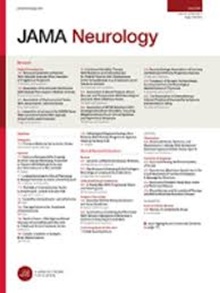Risk Factors Associated With Late-Onset Epilepsy in Dementia and Mild Cognitive Impairment
IF 20.4
1区 医学
Q1 CLINICAL NEUROLOGY
引用次数: 0
Abstract
ImportanceThe risk of developing epilepsy substantially increases after the age of 60 years (late-onset epilepsy [LOE]), particularly in people with cognitive decline ([PWCD] ie, dementia and/or mild cognitive impairment). Epilepsy is associated with worse cognitive and mortality outcomes in PWCD. Identifying PWCD at risk for developing LOE can facilitate early screening and treatment of epilepsy.ObjectiveTo investigate factors associated with LOE in PWCD.Design, Setting, and ParticipantsThis longitudinal, multicenter study is based on participants from 39 US Alzheimer’s Disease Research Centers from September 2005 through December 2021. Of 44 713 participants, 25 119 PWCD were identified. Of these, 14 685 were included who did not have epilepsy at enrollment, had 2 or more visits, and were 60 years or older at the most recent follow-up.ExposureThe association between various factors and LOE development in PWCD was investigated.Main Outcomes and MeasuresThe primary outcome was LOE, defined as seizures starting at or after 60 years of age. Those who did not develop LOE but were 60 years or older at follow-up served as controls. A multivariable Cox regression analysis assessed the association between various factors and LOE. Independent variables included age, sex, and socioeconomic factors (education, race, ethnicity), cardiovascular risks (hypertension, diabetes, hyperlipidemia), cerebrovascular disease (stroke or history of transient ischemic attack [TIA]), other neurologic comorbidities (Parkinson disease [PD], traumatic brain injury), cognition (age at dementia onset, dementia severity, type of dementia [Alzheimer disease (AD) vs non–AD]), genetics (apolipoprotein E4 [迟发性癫痫与痴呆和轻度认知障碍相关的危险因素
60岁以后发生癫痫的风险大幅增加(迟发性癫痫[LOE]),特别是在认知能力下降([PWCD],即痴呆和/或轻度认知障碍)的人群中。癫痫与PWCD患者较差的认知和死亡率有关。确定有发生LOE风险的PWCD可以促进癫痫的早期筛查和治疗。目的探讨PWCD患者发生LOE的相关因素。设计、环境和参与者这项纵向、多中心研究基于2005年9月至2021年12月来自39个美国阿尔茨海默病研究中心的参与者。在44713名参加者中,25119名残疾人士获确认。其中,14685人在入组时没有癫痫,就诊两次或两次以上,在最近一次随访时年龄在60岁或以上。研究了各种因素与PWCD患者LOE发展之间的关系。主要结局和测量主要结局是LOE,定义为60岁或60岁以后开始的癫痫发作。随访时年龄在60岁或以上但没有发生爱的人作为对照组。多变量Cox回归分析评估了各因素与LOE之间的关系。自变量包括年龄、性别、社会经济因素(教育、种族、民族)、心血管风险(高血压、糖尿病、高脂血症)、脑血管疾病(中风或短暂性脑缺血发作史[TIA])、其他神经系统合并症(帕金森病[PD]、创伤性脑损伤)、认知(痴呆发病年龄、痴呆严重程度、痴呆类型[阿尔茨海默病(AD)与非AD])、遗传学(载脂蛋白E4 [APOE4]状态)、生活方式(酒精滥用、脑卒中)。吸烟)和抑郁。结果14685例受试者中,女性7355例(50%),男性7330例(50%);平均[SD]年龄73.8[8.5]岁,221名(1.5%)参与者在随访期间发生LOE。在调整了人口统计学、心血管风险、神经系统合并症、遗传学、认知因素和抑郁因素后,以下因素与发生LOE的高风险相关:APOE4等位基因(校正风险比[aHR], 1.39;95% ci, 1.04-1.86;P = .03), 60岁前痴呆发病(aHR, 2.46;95% ci, 1.53-3.95;P, amp;肝移植;.001),认知较差(aHR, 2.35;95% ci, 1.97-2.79;P, amp;肝移植;.001), AD痴呆亚型(aHR, 1.68;95% ci, 1.13-2.49;P = 0.01),卒中/TIA (aHR, 2.03;95% ci, 1.37-3.01;P, amp;肝移植;.001), PD (aHR, 2.53;95% ci, 1.08-5.95;P = .03)。在敏感性分析中,使用65岁以后癫痫发作的另一种LOE定义揭示了与LOE相关的相同因素。结论及相关性本研究表明,APOE4等位基因、60岁前痴呆发病、AD痴呆亚型、认知能力下降、卒中/TIA和PD与PWCD患者的LOE发展相关。有这些危险因素的PWCD可考虑进行常规脑电图筛查,以早期识别LOE。
本文章由计算机程序翻译,如有差异,请以英文原文为准。
求助全文
约1分钟内获得全文
求助全文
来源期刊

JAMA neurology
CLINICAL NEUROLOGY-
CiteScore
41.90
自引率
1.70%
发文量
250
期刊介绍:
JAMA Neurology is an international peer-reviewed journal for physicians caring for people with neurologic disorders and those interested in the structure and function of the normal and diseased nervous system. The Archives of Neurology & Psychiatry began publication in 1919 and, in 1959, became 2 separate journals: Archives of Neurology and Archives of General Psychiatry. In 2013, their names changed to JAMA Neurology and JAMA Psychiatry, respectively. JAMA Neurology is a member of the JAMA Network, a consortium of peer-reviewed, general medical and specialty publications.
 求助内容:
求助内容: 应助结果提醒方式:
应助结果提醒方式:


